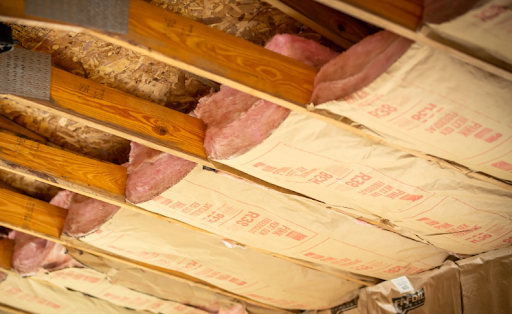Insulating a home is essential for comfort, energy savings, and long-term durability, yet not every solution addresses the challenges homeowners face. Some methods can be costly, difficult to install, or lose effectiveness over time, creating the need for a more practical option. This is where batt insulation becomes valuable. Pre-cut to fit standard framing, it provides consistent thermal resistance, effective sound control, and reliable performance without added complexity. Affordable, widely available, and simple to work with, batt insulation remains a dependable choice for improving both comfort and efficiency.
This blog will walk you through how batt insulation works, the different types available, its advantages and applications, and the best practices to ensure it performs effectively for years to come.
How Does Batt Insulation Work?
Batt insulation works by using a dense network of fibers—typically fiberglass, mineral wool, or cotton, to trap millions of microscopic air pockets. Because still air resists heat flow, these pockets slow transfer in three ways: conduction (air between fibers disrupt direct heat paths), convection (air is immobilized, limiting movement), and radiation (fibers scatter and absorb heat waves). Fiberglass batts deliver about R-3.0 per inch—a 3.5-inch batt in a 2×4 wall provides roughly R-11, while thicker batts in 2×6 walls can reach R-19. When installed snugly between studs or joists, batts create a continuous thermal barrier. Proper fit is essential, as gaps or compression allow heat to bypass the insulation.
Types of Batt Insulation
Fiberglass Batts
The most common option, fiberglass, uses spun glass fibers formed into flexible mats. It’s lightweight, cost-effective, and available in standard widths for studs and joists, as well as high-density versions that boost R-value in limited space..
Mineral Wool Batts
Made from basalt rock or industrial slag, mineral wool is denser than fiberglass and offers excellent fire resistance and sound attenuation. It’s easy to friction-fit in stud bays and is naturally water-resistant.
Cotton/Denim Batts
These batts repurpose textile fibers and are popular for low-itch handling and recycled content. They can be bulkier, so precise cutting and fitting matter. They also tend to cost more and may require a bit more effort to cut cleanly.
Faced vs. Unfaced Batts
Faced batts include a kraft paper or foil-scrim facing that can act as a vapor retarder when installed toward the conditioned side. Unfaced batts are used where a separate membrane is planned or where vapor control isn’t required by code.
Pros and Cons of Batt Insulation
Here are the main benefits and drawbacks of using batt insulation in your home:
Pros
Budget-Friendly
Material costs are lower than many rigid or foamed-in-place alternatives, making batts a solid value for large, accessible areas. Their affordability allows homeowners and contractors to insulate extensive spaces without overspending.
Widespread Availability
It is widely stocked in multiple R-values and sizes, making it easy to source for any project. Its availability at most home centers and supply stores simplifies planning and installation. For both new builds and retrofits, finding the right fit is straightforward.
DIY-Friendly
Batt insulation is easy to install since it comes in pre-cut panels designed for standard framing. With simple tools like a utility knife and stapler, DIYers can measure, cut, and fit batts into place. Its straightforward process makes it one of the most accessible insulation options for homeowners.
Sound Control
Denser batts, especially mineral wool, provide effective sound absorption, noticeably cutting airborne noise between rooms and floors. This makes them ideal for bedrooms, offices, and multi-level homes where acoustic comfort matters.
Cons
Installation Sensitivity
Batt insulation performs best when fitted carefully and evenly. Gaps, compression, or uneven cuts can reduce effectiveness, and obstacles like wiring or plumbing may require extra attention to ensure full coverage. Proper handling helps maintain R-value and overall performance.
Moisture and Air Considerations
While batts provide thermal resistance, they do not block air movement on their own. Drafts or persistent moisture can affect efficiency and, in some cases, lead to mold if not managed properly. Combining batts with appropriate air sealing and moisture control enhances long-term results. In situations where extra air sealing is required, it is better to consult spray insulation companies near you!
Where Is Batt Insulation Used?
Exterior Walls
Batts sized to 2×4 or 2×6 framing are common in new construction and renovations. High-density options help reach code-required R-values where depth is limited.
Attics and Roof Assemblies
Between joists or rafters, batt insulation is frequently used for its speed and low cost. In vented attics, it can be combined with blown-in insulation or placed above air-sealed ceilings. Batts help limit heat transfer through the roof, keeping attic spaces more energy-efficient and indoor temperatures stable. Use baffles at eaves to keep ventilation paths clear.
Basement and Crawlspace Walls
Batts can be used on framed walls, but moisture management is critical. Many builders prefer rigid foam against masonry with a framed wall and batts to avoid condensation risks. Follow local codes and building science best practices.
Floor Systems and Mid-Floor Assemblies
In floor systems, batts serve an important role by adding thermal resistance over unconditioned areas such as garages, helping to minimize heat loss. They also improve acoustic separation between levels, cutting down on noise transfer in multi-story homes. When installed properly, batt insulation enhances both comfort and quiet throughout the house.
Interior Partitions
Mineral wool batts are a popular choice for home offices, bedrooms, and media rooms where sound damping matters as much as thermal performance.
Maintenance and Lifespan
When properly installed and kept dry, batt insulation can last for decades, often exceeding 50 years. Its fibers do not degrade over time; performance issues usually result from moisture, pests, or physical disturbance rather than age. Here’s what you need to take care of them: –
- Inspect attics, rim joists, and wall cavities for moisture after rain or plumbing work and fix leaks promptly.
- Reposition any displaced batts and secure facings if moved during electrical or plumbing work.
- Avoid placing heavy items on batts to prevent compression; use raised platforms if storing in attics.
- Seal exterior entry points to keep rodents out and protect insulation from damage.
- For guidance on code requirements, vapor control, or moisture management, searching for local professionals experienced in best practices and climate-specific recommendations can help.
Conclusion
Ready to make your home more comfortable and energy-efficient? Batt insulation is an easy and effective way to cut costs, reduce noise, and keep rooms at the right temperature year-round. At May Energy Solutions, we provide trusted batt insulation that fits your home perfectly. Let our team help you get lasting comfort and savings.

